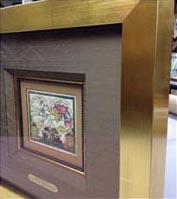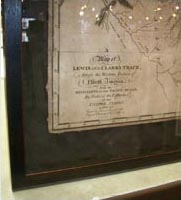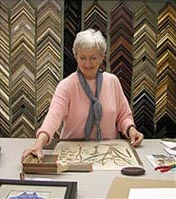Custom Framing in Boulder, CO
- We have over 35 years experience custom framing antique maps and prints in our gallery in Boulder, Colorado
- Choose from a number of framing options or let our expert staff do the designing. Open 7 days a week, no appointment necessary! Turnaround time is 3-4 weeks.
- We use only archival materials in our framing, i.e. Acid free mat board and backing, ultra-violet protection glass.
- We can provide images via email of your framing job.
- Gift cards included upon request.
Art Source International in Boulder, Colorado is your full service custom frame shop. We do archival framing executed to museum standards. We use conservation glass & acid-free cotton mat board to preserve your framed work. Our experienced custom framers in Boulder are here to work within your budget and to your particular standards and tastes.




We specialize in preservation of valuable documents and memorabilia.We have over 2000+ moulding corner samples on display for your consideration. We also have access to 10,000+ more moulding samples through our catalogs. We will take the time and care to help you design the perfect framing you need to enhance your home decor. Our frames cover a wide range of designs and prices.
No Job is too big or too small
Four full-time Professionally Certified Framers
We carry one million dollars in liability insurance
If you live in Boulder, or anywhere in Colorado stop by and
let us handle all your framing needs.
Quality Materials
We have thousands of fine mouldings from which to choose with a tremendous selection of contemporary and traditional styles, Italian carved mouldings, gold leaf, exquisite lacquers and flat finishes. We exclusively use archival materials including acid free matting and mounting materials, UV protective glass as well as Acrylic Shatterproof glazing is also available for an extra level of protection.
Experience
After framing thousands and thousands of items we have perfected the art. We also have substantial experience framing for two-sided viewing of documents and memorabilia.
We can also do shadow box framing.
Dedication to the Highest Standards
Each item receives the personal attention and special care of our Certified Framers. We understand the value each piece holds for its owner, whether it be monetary or sentimental, and treat each item with the utmost respect.
Conservation Framing
What is Conservation Framing?
Conservation framing is the use of the highest quality rag material to surround the artwork . Special techniques and procedures are used to protect the work with regards to mounting . It is a process that is always reversible, therefore the artwork’s integrity is never compromised.
When Should Conservation Framing Be Used?
While conservation framing is generally used for paper borne art and documents of high monetary value, conservation framing should be used anytime a high degree of protection and preservation is desired for a framed piece. Examples would be historical documents, present day as well as antique photographs, and mementos.
What Does Conservation Framing Do?
Everything will deteriorate given time and exposure to the environment. Conservation framing is designed to minimize deterioration by the environment and to avoid contributory deterioration by the materials that surround the artwork. Some of the factors of this deterioration are:
Humidity & Temperature
High temperature and humidity levels can accelerate the growth of mold inside the frame. Mold is often seen as a ghostly image on the glazing material. Mold formation cannot be totally eliminated and as a result the frame should be disassembled every 3-5 years to remove mold that has formed.
Artwork should be spaced from the glazing materials to provide an air space to prevent the condensation of moisture onto the paper and allow a small air space for the inside frame atmosphere to adjust for increased levels of moisture in the air. Spacing is achieved by the use of a mat or spacer between the glazing and the artwork. Sudden changes of temperature and humidity should be avoided as heavy condensation may wet and damage the artwork. Foxing is red or brown spots that appear on the surface of the paper. While the exact cause of foxing is not totally understood, it appears to accelerate under high temperature and humidity conditions. Atmospheric pollution or dirt or dust may combine with moisture in the air to form harmful acids that will attack the artwork.
Light
The effect of light on art is insidious and not readily apparent. Ultraviolet rays damage artwork in two ways. Strong fluorescent lighting or direct sunlight may fade color. Paper also tends to absorb high-energy photons which causes a chemical reaction in the paper, breaking it down and causing it to turn brittle. The effects of light on materials can be reduced by the use of glazing that filters out harmful ultraviolet rays.
How Does Conservation Framing Work?
The theory behind conservation framing is to enclose the item in a non-hostile environment and to give it protection from the general environment. The general components of a conservation-framing job consist of the frame, the glazing, the mat or spacer, the backing and the hinging. Mats, backing, hinging and glazing must consist of 100% acid free material of conservation quality approved by the Library of Congress. Hinging should be of acid free materials with a water-based activated adhesive. Under no circumstances should pressure-sensitive adhesives be used on paper as these adhesives change character over time and the adhesive is known to migrate into the paper. To retain the original state of the artwork, it should not be cut, folded or mounted or glued to backing boards. Museum grade (Dahle) corners can be also used. This method resembles photo corners and does not require any sort of adhesives to come in contact with the artwork.
Matting
The primary purpose of matting is to separate the artwork from the glass. Since paper expands and contracts with temperature and humidity changes, the mat allows room for that inside the frame. Mats should also enhance the beauty of the artwork. They should create, if you will, a funnel along which your eye is drawn to the image. The matting should be the secondary thing your eye finds.
Hanging & Care of Picture Frames
Cleaning Your Frame
Wood finish frames may be cleaned with a gentle furniture-dusting product like Endust applied with a soft cloth. Gold or silver-leafed frames should be dusted with a dry soft cloth. Metal frames may be cleaned with a glass cleaner applied to a soft cloth. When cleaning the glass NEVER SPRAY THE ARTWORK DIRECTLY! Liquid spray will run behind the glass and eventually add moisture to the inside of the frame as well as stain the mats and or artwork. Use a quality plastic cleaner and a soft cloth for Plexiglas.
The side of the glass on the inside of the frame should be cleaned and checked at least every 3-5 years. The frame must be disassembled to accomplish this cleaning. This procedure allows for checking the condition of the hinging of the artwork, mats, the tightness of the corners of the frame, etc.
Hanging Your Picture
All frames should be hung with the use of picture hooks. Hanging artwork from a nail increases the danger that the frame could fall off the wall. A nail over even a short period of time with the weight of the frame and artwork together will most likely roll the nail out of the wall. Depending on size, one or two hooks should be used. In cases of very heavy frames the use of wire is not recommended. The use of two hooks is the safest and best way to secure such works to a wall.
Where to Hang Your Frame
Picture frames are usually displayed at eye level. This is not a hard and fast rule, however, and consideration must be given to individual needs. Paperborne art is not recommended to be hung in high humidity location such as bathrooms. Consideration must be taken of high airborne pollution locations such as kitchens (grease, cooking pollutants). Direct sunlight is also to be avoided due to heat and ultraviolet light exposure considerations. Although over fireplaces is a popular place to hang art, consideration must be given to the factors of heat and soot possibly contaminating or damaging the artwork. Consult your framer in these cases. He or she may be able to recommend solutions to these problems.
Frame Types
- Wood Frame – Frames made out of wood are generally the preferred choice. Wood frames provide the largest choice of colors, shapes and sizes. The only drawback to wood frames are that the cost is usually a little more than a comparable metal frame.
- Aluminum Frame – Metal frames of today are not the same boring chrome frames of the 70’s. Frames made out of metal are now very creative with their special color.
- Plastic Frame – Frames made out of plastic are generally used for large quantity frame jobs due to its low price. However, the structural integrity of plastic frames is not very good when used for the framing larger pieces.
- Acrylic Box – The acrylic box frame is a great choice for object framing. The frame is very light weight and can made in many sizes.
Glass Types
- Clear Glass – This is the traditional picture framing glazing material.
- Non-Glare Glass – This glass reduces the reflection on the glass which is often seen with clear glass. A non-glare glass will sometimes distort the art image so it should only be used when reflection is a large problem.
- Reflection Control Glass – This is a high-grade non-glare glass. Reflection control has the same purpose as traditional non-glare, however it produces less distortion of the art image.
- Conservation Glass (Includes Clear & Reflection Control) – Conservation glass is coated with a special material which filters out 97% of ultra-violet radiation. UV light is what causes the fading of your matting and artwork.
- Anti-Reflective – Sometimes known as invisible glass, when this glass is used, reflection is not visible. This is a premium glass that is sold under the names of Den Glass and Image Perfect.
- Clear Acrylic – This gives the same look as clear glass, but is much lighter.
- Non-Glare Acrylic – This gives the same look as non-glare glass, but is much lighter.
- UV Clear Acrylic – Ultra-violet protective acrylic
- Image Perfect – This glass is a porous surfaced non-glare glass. It absorbs glare and makes the framing look almost glassless.
Matboard Types
- Paper Pulp Mat – This matboard is the least expensive of all mats. The matboard should only be used on inexpensive artwork such as posters due to the fact that it contains acids, which can hurt original or limited edition artwork. Many companies manufacture this type of matboard.
- Rag Mat – 100% museum grade conservation matboard. Used for original art, limited edition prints.
Framing Advice
Original artwork should be matted with rag matboard. Artwork should not be hung in direct sunlight. If direct light is a problem, you should consider using conservation glass or UV filtering Acrylic. Consider rotating artwork that is hung in direct sunlight. It is still not recommended to hang art in direct sunlight as the inside of the frame can reach high temperatures. Try to avoid hanging artwork in areas of temperature fluctuation or where humidity remains over 70% for long periods of time.
Framing Standards
Do not trim the edges of valuable artwork, it diminishes the value.
Moulding
Do you want a traditional moulding or a modern look? Do you want a simple moulding or a more decorative one? If you know where the piece will be hanging it’s good to take the accompanying decor into account. In offices people often either 1) choose a moulding that resembles the furniture color or 2) choose an antique gold moulding or a black moulding and bypass matching the furniture. For homes, people choose what they like!
Estimating the Size of Your Framed Piece
The image size of the map is listed with the map. If you are using our standard mat sizes, add 9-10″ to both the image height and width. This will give you an approximate size of your framed piece and includes the border, mat and moulding. The exact size will of course depend on the width of your moulding, the border size and the mat size.

